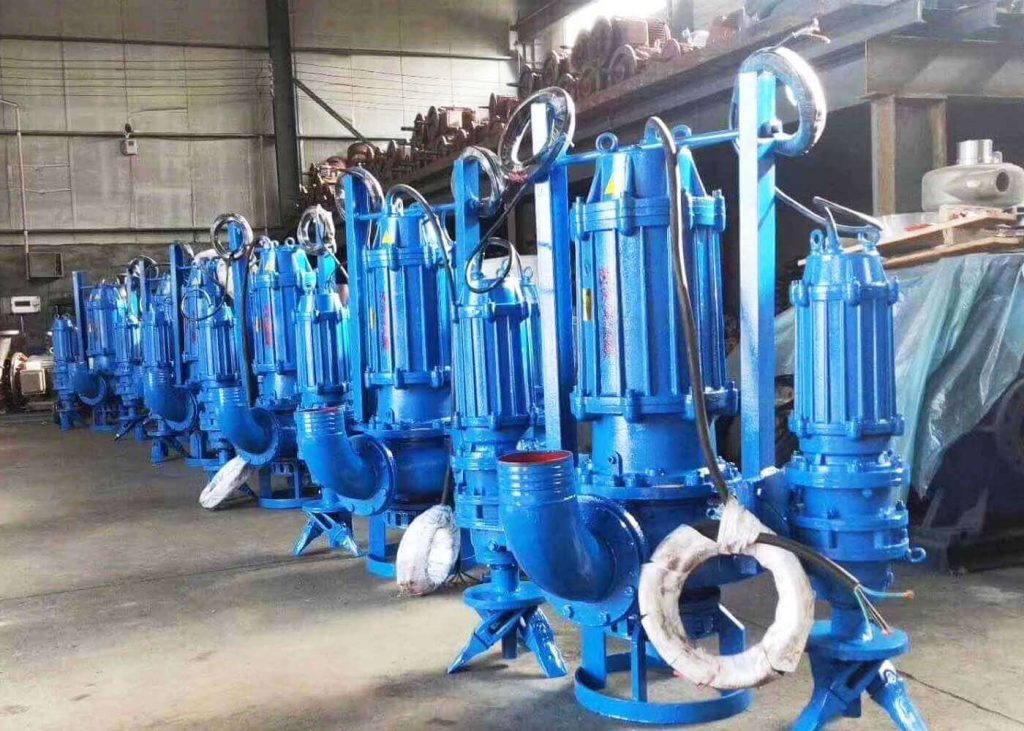Submersible Slurry Pumps Clogging, We Have A Solution
A submersible slurry pump is a powerful and efficient machine designed to transport and handle large volumes of water mixed with solids (called slurry). Submersible slurry pumps are essential for industrial and mining industries, but clogging is one of the most common and important problems. This happens when solid particles in the slurry get stuck in the pump, blocking its flow and eventually causing it to fail. The effects of a clogged pump can be severe, leading to reduced efficiency, increased energy consumption, increased downtime for maintenance and repairs, or even complete pump failure. We should correctly understand the causes of submersible slurry pumps and blockages and take measures to prevent this problem from happening.
Submersible slurry pumps are widely used in various industries, such as mining, construction, and dredging, including pumping and washing sand, river dredging, renovation of lowland
Tailings transportation, etc. Unlike traditional pumps that sit above the water, submersible slurry pumps can be completely submerged in the liquid they pump. This makes it ideal for applications where slurry needs to be pumped from great depths or in environments where space is limited.

Causes of clogging of submersible pumps
- Large solids or debris present in the slurry
These solids can clog the pump impeller and volute, impeding flow and reducing its ability to move fluid efficiently. This is more likely to occur when working with abrasive or corrosive slurries containing hard or sharp-edged materials.
- Excessive impeller wear
Over time, the abrasive particles present in the slurry can corrode the impeller blades, resulting in reduced pump performance. This wear reduces efficiency and increases the risk of clogging, as damaged blades are more likely to allow solid particles to accumulate.
- Improper installation and operating practices
If the pump is not properly aligned with its discharge line or has sharp bends or restrictions in the piping system. This may cause a pressure imbalance, leading to blockage. Additionally, operating a submersible slurry pump with proper maintenance and attention to regular inspection intervals can further exacerbate potential clogging problems.
A variety of factors can cause blockages. Blockages pose a safety risk and can have costly consequences for industries that rely on submersible slurry pumps to operate.
Solutions to avoid clogging of submersible slurry pumps
Submersible slurry pumps are an efficient and reliable method of transporting abrasive and heavy materials. However, just like any other type of pump, they can sometimes experience problems. One of the most common problems with submersible slurry pumps is clogging. Here are some tips on how to avoid clogging in your submersible slurry pump.
1. Choose the right pump:
Choosing the right submersible slurry pump is the first step to avoiding clogging. Ensure the pump can handle the maximum particle size and solids concentration of the material being taken. Such as temperature, viscosity, and chemical compatibility must also be considered. Pump design and performance parameters should match the application requirements.
2. Install a suitable flotation device:
Submersible slurry pumps are designed to operate underwater, but without proper buoyancy, they can easily suck in sediment and clog the pump. Install the correct flotation device to keep the pump off the bottom and away from sediment.
3. Use a suction filter:
A suction filter will help prevent large particles from entering the pump and causing blockage. Be sure to choose a filter with the correct mesh size to match the pumped material. Also, make sure to clean or replace the filter regularly.
4. Keep the impeller clean:
The impeller is the heart of the pump. If it is blocked by debris, it will seriously affect the pump’s performance. Regular inspection and cleaning of the impeller will help prevent clogging and keep the pump running smoothly.
5. Control slurry concentration and speed:
Keeping the slurry concentration within a controllable range and avoiding an overly thick slurry will help reduce the possibility of clogging. The operating speed of the pump is controlled to suit the fluidity and particle size of the slurry.
6. Consider upgrading to a self-cleaning design:
Some pumps can be equipped with a flushing system that flushes the inside of the pump to prevent particle build-up.
Walker Submersible slurry pumps advantages
(1) A submersible slurry pump can handle highly abrasive materials without excessive wear.
The rugged construction of these pumps allows them to withstand the attack of mud and continue to operate efficiently for long periods. Additionally, these pumps are designed with high flow rates. They can handle large solids, making them suitable for demanding applications such as mine dewatering or conveying gravel or rock slurries.
(2) A unique feature of submersible slurry pumps is their adaptability to different liquid levels.
Because they are completely submersed in water, they are not as dependent on priming (filling the pump casing with liquid) before operation as other types of pumps are. This eliminates the need for constant monitoring and adjustment when treatment tank levels fluctuate, or process requirements change. They operate reliably even at low water levels or where air entrainment is possible (common challenges with conventional pumps).
Overall, a well-designed pump with a proper impeller, maintaining consistent flow rates, and implementing regular maintenance practices are all key strategies to avoid clogging in a submersible slurry pump. These methods not only improve operating efficiency but also extend the life of the equipment by reducing stress and damage caused by clogs. Walker offers various types of high-quality pumps made of high-strength, wear-resistant materials; if you have any needs, please consult us!
